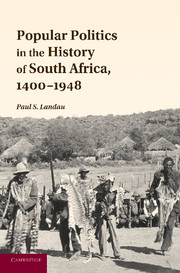Book contents
- Frontmatter
- Contents
- List of Figures
- Preface: The Birth of the Political
- Acknowledgments
- 1 Eyewitness Engagements (Highveld political discourse at the start of the 1800s)
- 2 History before Tribes (Partnership, alliance, and power)
- 3 Translations (Missionaries and the invention of Christianity)
- 4 The Incipient Order (Moroka's reign, 1828–1880)
- 5 Mixed People (The Samuelites, the Griqua, and other subjectivities, 1880–1928)
- 6 Twentieth-Century Tribes
- Primary and Archival Sources
- Bibliography
- Index
2 - History before Tribes (Partnership, alliance, and power)
Published online by Cambridge University Press: 04 August 2010
- Frontmatter
- Contents
- List of Figures
- Preface: The Birth of the Political
- Acknowledgments
- 1 Eyewitness Engagements (Highveld political discourse at the start of the 1800s)
- 2 History before Tribes (Partnership, alliance, and power)
- 3 Translations (Missionaries and the invention of Christianity)
- 4 The Incipient Order (Moroka's reign, 1828–1880)
- 5 Mixed People (The Samuelites, the Griqua, and other subjectivities, 1880–1928)
- 6 Twentieth-Century Tribes
- Primary and Archival Sources
- Bibliography
- Index
Summary
One comes without much notice upon the ruin of Great Zimbabwe. Its apparent volume is washed in shadow, inconspicuous at a distance like the breeze-block storefronts of Masvingo, the nearest town; but as one approaches, there suddenly is its curved, looming edifice, in coursed, gray granite bricks, mottled in orange lichen. No mortar lies between the rectangular stones. The outer wall is built thick as a schoolbus and ten meters high; at the top, there is a delicate chevron pattern. The main structures in stone date from the fourteenth century.
The immediate surrounding area is laced with low stone walling, the skeletal remains of a thriving urban zone. Once, the whole neighborhood was teeming with people, living in wide, thatched rondavels of red earth and manure. The archaeologist T. N. Huffman, drawing on the historian David Beach's work, has subjected the site to the most ambitious and thorough analysis. The critical invention at Great Zimbabwe, according to this pioneering scholar, was to pattern popular loyalty repeatedly with age-grade initiation ceremonies, featuring circumcision. Huffman argues that the central stone enclosure was a gendered, sacred space, and that religious ceremonies gave it its subjective power. Against this interpretation, it has been noted that none of the early Portuguese sources for the Zimbabwean highlands mention male initiation schools or genital circumcision, which were certainly known on the South African highveld. Even more, the attribution of religious power to polities of the past should not so easily be accepted.
- Type
- Chapter
- Information
- Publisher: Cambridge University PressPrint publication year: 2010

